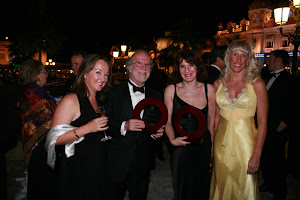
In the UK, Axxia with their product DNA is up against the likes of Thomson Elite 3E, Aderant, and CS Group (CS Group are a UK software venture capitalist who own AIM, Videss and Laserforms - all bought out in the last two years). Axxia historically offer case and practice management software and have a strong time & billing component aimed mainly at mid tier firms. (Think of it like an all day travelcard rather that a one way ticket).
Stuart Holden, Managing Director, Axxia says of their product which launched just over a year ago. “Its taken three years of commitment and investment to bring our dedicated legal, ‘DNA’ product to market. We liken DNA to SAP – it does everything a firm needs rather than buying separate silo’d bits like CRM or billing then glue-ing them together.”
Stuart says he was delighted to see my 3E article recently in Citytech. He believes there’s been a general lack of debate about law firms and their approach to technology which has led to a sleepy market. He thinks with 3E stirring things up with a new approach is just the kind of thing that will help law firms realize they are at the dawn of a new age. Stuart comments “we’ve been out there talking about law firms needing to change for a while but only a few are picking up on this. In my view adapting to change is going to be an essential element to enable them to stay in the increasingly competitive legal game.”
Although time and billing has always been a strong component of Axxia’s offering, Stuart says DNA is more than this now. In his view their offering is aligned to SAP (a European vendor who dominates in Germany and non-legal in the UK) rather than running up against the likes of stalwart vendor Thomson Elite 3E. Stuart says “3E handles part of what a law firm does and handles it well. DNA handles the whole lot: time and billing, CRM, DM, practice and case management.” He sums up “DNA offers everything that interfaces with what the lawyer needs to do.”
Stuart continues “Its took us three years and a lot of thought to develop DNA and we do feel we’ve got it right and can steal a lead on the competition.” He adds “The way lawyers deliver law is changing; already we’ve seen the competitive-end legal markets like conveyancing commoditise which means firms have had to adapt their business to more demanding, cost sensitive clients. We’ve monitored this progress for some time now and developed DNA to mirror this business revolution.” Although Stuart hastens to add “We don’t preach, we know all law firms rely on individual strategy. As an example CRM may need a different approach for every practice area.”
Stuart sees billing as a high spot that will present challenges and growth for firms and says
“The larger law firms are most interested in DNA – the ones who’ve written down most of their processes and are gearing up for increased profitability.” But adds “For the moment we aren’t selling into the multi jurisdiction operations but are talking to large national firms in the UK and Australia.” He continues further “We are also turning heads in progressive mid size law firms. They’ve realized if they can put change through the firm and enablers to make it work for them then both will act as a major benefit over competitors.”
Asking about Thomson Elites 3E which started over (different product to their legacy Enterprise app.’) he agrees 3E have a valid argument that software has moved on considerably and would only mean compromises if they didn’t make the break. He comments “the pedigree of their enterprise product goes back many years but even so, from a theoretical point and depending on what they are working with, you do have to start again at some stage. It is the right thing to do. The only problem is migrating users.”
He continues “We took a different approach, partly because our design wasn’t at the end of its lifecycle. Also because our users depend on a workflow process using many areas of our software together As an example if you consider Pannone or Weightmans who use workflow throughout their firm: lawyers/attorneys and back office, if you say tomorrow lets pull the plug, change the whole thing and expect it to work, its not going to happen. Maybe in the back office it would be ok - its painful but do-able but when you have everyone connected to it, you will inevitably get problems and downtime. For this reason we felt we had to design in co-existence. So when firms are rolling out they can stay on their existing workflows, phase it in and unplug the old when they are ready. Stuart comments “Its slightly different with time and billing silo’d software because firms can unplug and switch the next app.’ in, because its mainly back office focused.”
I mentioned that Thomson Elite 3E said that decision making for their product was starting to shift to IT Directors (over the FD). Stuart says “We generally talk to the whole management team which includes FD, IT, Managing Partner and CRM head because clients are realizing that the decision is multi faceted.”
I wonder at this stage about connectors to other software like Lexis Nexis InterAction (which is heavily invested in many law firms) particularly as Axxia is saying ‘you just need us now.’ He hesitates saying “DNA is a web services app’ so will connect to any CRM /DM but we think there are more benefits to using DNA than silo’d app’s.” He continues “We work with the Microsoft suite which is also a SAP model. We don’t write bits of it our self and interface so can’t segment it unlike best of breed. (Editors note: Large app’s like Interface InterAction/3E stay like this because law firms can go deeper into applications – it gives more developing capability). Stuart elaborates “Our background with applications has also been manufacturing which means we link every process. We see legal in the same way ie with areas that should blend together.
I mention the new wave of thinking ‘phasing’ rather than ‘big bang’ implementations and wonder what Stuarts views are: “There are several reasons for phasing: firstly firms want to see benefits for going through the pain. In my view it’s a sensible way of doing things.” He continues “Axxia have very slick implementations with three to four months for PMS (practice management software) and for case it could vary but would usually be a month to two months.” I comment on their phenomenal speed and Stuart says. “Our view is if we get it in quickly, then clients can tweak it and do their own thing rather than us spending hours consulting. Ultimately its down to our design. Although DNA is similar to say Visualfiles, in terms of the complexity of what could go into it, our experience says, keep everything very simple. Don’t try and design an ultimate, just let clients build upon it.” He adds “We could have done something much more combative and competitive but don’t think there were many that could have written with the straightforwardness of DNA.”
So the acid question. Who’s buying it? Stuart says “We’ve got DNA in part rolled out to six or seven firms and one firm with around 150 users is in its last phase now.” He continues “We are seeing a lot of activity in non legal like government for managing processes and dealing with compliance. Gordon Brown wants to lose civil servants so is making them more efficient with automation.”
I ask how all the players in the market will shape up with so much competition. Stuart believes that some companies will fight on price with no real product development but agrees with Kaye Sycamore, who just got promoted to a big boss role at Thomson Elite 3E in saying “you need to buy something you can grow into in future not something that is about to retire. If you buy older systems not built on new, faster platforms then you are likely to have to repurchase again in the foreseeable future”
Axxia is a privately owned software company that was bought out by the management including Stuart some years ago which publishes financial results every year. Stuart says “having worked in big groups delivering quarterly results it is a relief to publish annually. He says “to be able to put a strategy together for five years and really work it and for us the launch into Australia too is something we wouldn’t have necessarily achieved. The freedom from this constraint allows us to do a better job.”
And will they sell to any of the VC’s stalking legal? Stuart says firmly: “We are not for sale.” He continues, “What we are and what we’ve invested will not reflect any valuation. We aren’t positioning for exit we want to ride the next wave of success which we see in our sights within three years.”
And the market as a whole? Stuart says “there is lots of change which is creating a lot of buzz and Thomson Elite’s 3E is helping. We feel IT selling has gone very consultative now. When we drill into issues they normally become very complex. So we treat bigger picture rather than symptoms.” He continues “3E is helping us all sell the concept of workflow and nailing down processes which is creating the needed debate in law firms.” He adds “As well that what other companies like CS Group have done, is create uncertainty. If you are AIM or Videss users (both case/PMS vendors pitching mid tier bought out) you have had to swallow change so its gotten people thinking. Aim users were very loyal to Aim and were very difficult to convert. The uncertainty of the buyouts has created opportunity.” He continues further “We have good product strategy, we are cash rich, profitable, have loads of users and are in an enviable position.”
VC (venture capitalist) stalkers in the sector are sniffing around vendors worth around £5mill. I dig to see if I can get a valuation on Axxia. Stuart is number shy but says “we are not in the CS Group buying space they would have to pay more than £10million.”
Stuart is very optimistic about Axxia’s future. “We are always more successful when there is an aggressive market out there.” He says, then adds combatively “Let the best product win.” He believes that the main four players, (Axxia, Aderant, Thomson Elite 3E and CS Group) are really shaking things up.
Although Stuart compares DNA to SAP – both having a broad product, covering all areas, like HR, CRM and time & Billing he says that SAP have brought their legal product to the market from a very complex enterprise solution. He says “They’ve scaled it down into an SME product” but he believes, Axxia, Aderant and others understand legal nuances more. He continues “There are some comprises SAP can make, but there are a lot they can’t. He interjects “I expect we have an advantage over SAP but SAP will find its niche. Those buying it in after having had legal specific software will lose legal specific functionality.”
I give Stuart his opportunity to tell us why you should buy DNA. He smiles and says “its different and unique. What we’ve done for the first time is take what the legal market is asking for and added from outside industry what they will need in future years. Order processing, planning, identifying where work is coming from and business process which will be very important. Law firms do need to change and work in future will be very process led.”
He continues “Business agility is the buzz.” I ask what that really means. He confirms: “Ability to respond to compliance and increase in legislation.” Then adds “we all have to respond to change however it hits us even if just because we’ve designed a better way to do business. Tech agility is about being able to do it in an energising way to ensure you aren’t outwitted or crippled by the process.”
Moving on to general views. I mention Clementi which is a UK law change which the press are saying will result in the ‘death of the smaller law firm.’ It deregulates law firms here saying that any company can now offer the same service ie hire a team of lawyers and deliver law and allows support staff into equity structures. I wonder if this is really true and if in fact ‘tesco law’ providers will just create new business markets not yet seen? Stuart thinks and responds “the counseling aspect is missing from the ‘tesco law’ idea.” Then adds “Computers can replace the way lawyers operate but can’t cope with the emotional decisions that keep deals on track.” He continues “A firm in Australia is looking at franchising their software to other lawyers. It would mean if you walked into a high street, firm he could use software expertise from a bigger firm which would help small firms compete.”
On after sales service? Stuart has a novel approach “I think clients should phone up and get through to someone, we have log webbing for problems, we don’t have automated messages on phones we divert to a human.” He continues “Service is coming back into fashion - internet purchasing works well when it works. Touch points (where clients interact with your firm) will be very important.”
And a last word on business agility: “Everyone accepts its, not the big firms which will snack on the small, it’s the quick who will win the race. If you can’t change quickly you will get left behind. Axxia is leading by example. We are changing the culture of our company as we go into high impact sales and putting staff into training programmes. We’ve also hired a non exec onto the board to bring in external expertise.”
He finishes “Clients will determine everything and what change is required. Law firms will decide winners and losers. Law firms are slow to want to change but when they decide to go for it they are quick.”□






No comments:
Post a Comment